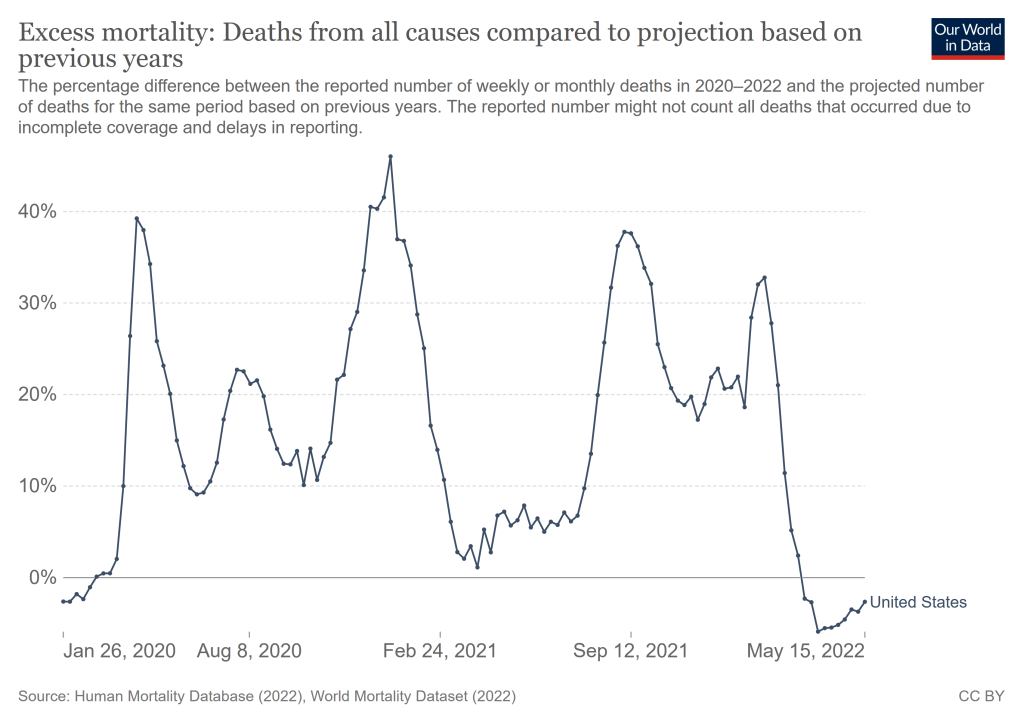
Note: This post was updated on 7/21 and 7/28/22, to include hospitalization data spanning a longer chronological range and national level excess mortality estimates, and on 8/29/23 to fix an incorrectly linked data source.
In November of 2021, the Omicron variant of the SARS-CoV-2 virus was discovered in the Gauteng region of South Africa. Early research painted a worrying picture. It was reportedly four times more contagious than the already highly transmissible Delta variant and was better at evading immunity, resulting in a marked decrease in the effectiveness of existing vaccines. There was an additional discovery: the variant was less likely to cause serious infection in lung tissue, raising the possibility of milder illness and lower rates of hospitalization. Researchers were quick to point out this wasn’t evidence of the virus evolving to become less severe (Omicron didn’t evolve from Delta) or that the variant didn’t present a serious threat. Imperial College London’s Neil Ferguson stated that “our analysis shows evidence of a moderate reduction in the risk of hospitalization associated with Omicron variant compared with the Delta variant….However, this appears to be offset by the reduced efficacy of vaccines against infection with the Omicron variant.” The University of Hong Kong’s Dr. Michael Chan Chi-wai, a faculty member involved in one of the aforementioned studies that indicated Omicron’s propensity for less severe respiratory infection, noted that “the severity of disease in humans is not determined only by virus replication but also by the host immune response to the infection.” He warned that Omicron could “cause more severe disease and death simply by spreading much faster, even though the lung infection appears not as bad.”
The mischaracterization of SARS-CoV-2 Omicron as a mild pathogen took hold in the greater public imagination, aggravated by some healthcare professionals promoting oversimplified explanations of “mild Omicron” with misleading statements about the “decoupling” of cases and hospitalizations and SARS-CoV-2’s transition to being an “endemic” virus. Additionally, many public health measures that had been put in place to blunt the transmission of SARS-CoV-2 were gone by the end of 2021. 2022 began with massive spikes in Omicron-driven COVID-19 infection erupting around the world, with one of the worst occurring in the United States (Fig 1). On January 12th, 1.2 million new cases were recorded in the US, with Omicron’s BA.1 sublineage being the dominant strain (accounting for more than 90% of sequenced infections.) The surge ended almost as quickly as it started, with daily caseloads much lower by early March than they had been at its beginning in late December.

During the BA.1 wave, deaths as a percentage of cases were a fraction of that seen in waves driven by prior variants. To describe the mortality that resulted from the outbreak in such abstract mathematical terms, however, is misleading. Because of Omicron’s greatly increased transmissibility, much more of the population was infected. Thus, the amount of death caused by the BA.1 surge was substantial, regardless of the strain’s decreased pathogenicity. Official COVID-19 mortality figures (Fig. 2) reflect this, but the limitations of this data are well known. Excess mortality estimates (Fig. 3) show that while the BA.1 wave was likely less deadly than all prior major surges, it was still highly lethal and comparable to the former*. Similarly, despite initial predictions of a decreased risk of hospitalization, the number of people hospitalized by BA.1 (Fig. 4) surpassed the Fall 2020/winter 2021 and Delta waves, being roughly 150% higher than the latter. More than 154,000 Americans were hospitalized nationwide as of January 19th 2022, almost entirely by a variant still widely being referred to as “mild.” Further analyzing hospitalization data, the number of these patients requiring intensive care was more or less equal to that of the Delta wave and marginally less than that of the 2020/2021 wave.



These data reveal the true severity of BA.1’s impact in the United States. Although the surge began in late December, the country’s cumulative COVID-19 death toll increased by more than 120,000 between January and March alone. By comparison, a particularly virulent seasonal flu can result in around 52,000 deaths. A recent study found excess deaths in Massachusetts were higher during the BA.1 wave than the Delta wave. Beyond mortality, there’s the uncalculated figure of how many Americans have sustained permanent injury, become disabled and joined the ranks of “long COVID” sufferers as a result of BA.1 infection. As disturbing as the effects of the BA.1 wave were, the government’s subsequent response was more unsettling. Funding for federal pandemic aid has been cut and top ranking officials have made the dubious claim that the most severe stage of the pandemic is over. The US is already experiencing another Omicron-driven surge, with the BA.5 sublineage (as of the publishing of this post) being the dominant strain. Preliminary data suggests it may have evolved to cause more severe disease. In the face of it all, numerous individuals and entities (the CDC included) carry on minimizing the continued threat of this virus.
*Alternatively, an estimate of excess mortality during the pandemic by The Economist found higher levels during the BA.1 wave than the Spring 2020 or Delta surges. Whichever measure is ultimately more accurate, the fundamental assertion that BA.1 caused a considerable number of fatalities in the US remains true.
Special thanks to Jeoffry B. Gordon, MD, MPH for his assistance during the drafting of this piece.





